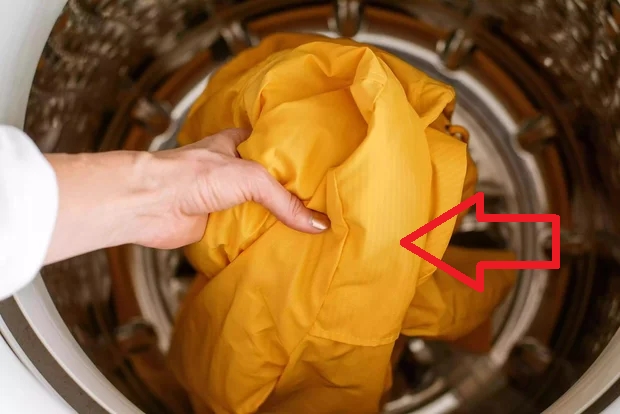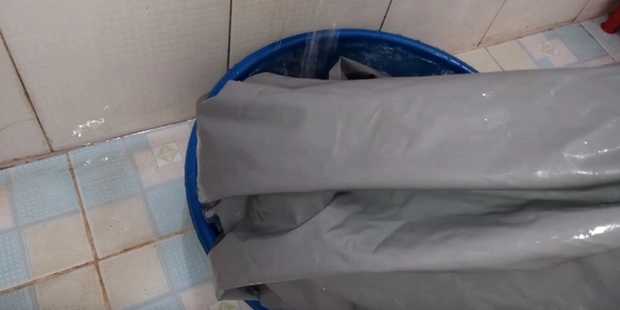Out of 10 people surveyed about what they do with their raincoats after getting caught in the rain, eight responded that they would dry their raincoat, give it a quick shake, and then promptly put it back in their car trunk. However, the correct answer lies with the remaining two people, who mentioned that raincoats need to be washed.
Washing a raincoat may seem like a simple task, but many people tend to forget or think it is unnecessary. However, this habit can cause raincoats to develop unpleasant odors, or, more severely, attract bacteria that inadvertently affect one’s life and health.

Therefore, it is best to wash your raincoat after each use, especially after heavy rainfall. For light drizzles, assess and evaluate the wetness of the raincoat and then proceed to clean it accordingly.
The website WikiHow has outlined the steps to properly wash a raincoat, ensuring that it is clean and its durability is maintained. This includes specific instructions on what to do before, during, and after the washing process.
Before Washing Your Raincoat
Before washing your raincoat, especially those that come with a trouser and jacket set and have pockets, thoroughly check these pockets for any foreign objects. Leaving these items in the pockets will hinder the washing process and prevent optimal cleaning.
Raincoats that come as a set usually have buttons and zippers. Ensure that these are all fastened and secured before washing. If they have elastic bands or straps around the hood and collar, tie them securely as well.
Raincoats will inevitably attract dust, debris, and leaves when worn outdoors. Before washing, use a cloth or paper towel to remove these surface contaminants. A better method is to use a brush and scrub the raincoat in a circular motion. Once most of the dirt has been removed, the raincoat is ready for washing.
Before washing, check the raincoat for any care labels. If present, these labels will provide specific instructions on how to wash the raincoat, for example, indicating whether it should be hand-washed or machine-washed.
However, most modern raincoats are made from materials such as PVC, synthetic fibers, vinyl, or nylon-coated fabrics. These types of raincoats can typically be hand-washed or machine-washed.
During and After Washing Your Raincoat
When machine washing your raincoat, the first thing to note is the choice of detergent. Some detergents contain strong chemicals that can damage the waterproof coating of your raincoat. Also, ensure that the detergent tray is clean and free of any old residue to avoid it sticking to your raincoat and causing abrasion.
Next, select the gentlest cycle to ensure that your raincoat doesn’t tear or damage its waterproof coating during the wash. Use warm water instead of hot water when washing.
At the end of the first cycle, you may want to run an extra rinse cycle to ensure that all detergent residue is removed from the raincoat. Finally, remove the raincoat from the machine and hang it to dry.
If you need the raincoat to dry quickly, you can use a dryer, but be sure to check the care instructions to ensure it can withstand the high temperatures.
Hand Washing
When hand washing a raincoat, the first step is to rinse it with cold water to remove any initial dirt and grime. This step is crucial, as your raincoat may not be completely cleaned otherwise.
Next, lay the raincoat out flat on the floor. The solution for hand washing a raincoat is typically a mixture of detergent and water. Pour this mixture directly onto the surface of the raincoat and use a brush or scrubber to scrub it evenly.

Raincoats have two sides, so be sure to scrub both the inside and outside surfaces to eliminate any bacteria that may cause unpleasant odors. If there are any mold spots on the raincoat that cannot be removed with detergent and water, use vinegar or rice wine.
Soak a cloth or scrubber in vinegar or rice wine and rub it vigorously onto the moldy areas. The acid in these liquids will quickly break down the mold. Finally, rinse the raincoat with clean water and hang it to dry.
When drying the raincoat, speed up the process by laying it flat or hanging it on large hooks. Once one side is dry, flip it over to ensure even drying on both sides.
Over time, some raincoats may lose their waterproof coating. WikiHow experts suggest purchasing and using a specialized waterproof spray for these cases.
To test if your raincoat’s waterproof coating is still effective, you can try the following:
– Sprinkle water on the surface of the dry raincoat.
– If the water beads up and remains after a few minutes, the waterproof coating is still in good condition.
– However, if the water is quickly absorbed instead of beading up, it indicates that the waterproof coating has worn off.
If you don’t have time to wash your raincoat immediately after getting caught in the rain, at least give it a quick rinse with water. This will help remove any dirt or grime that could cause mold and unpleasant odors.
According to Xe và thể thao

































